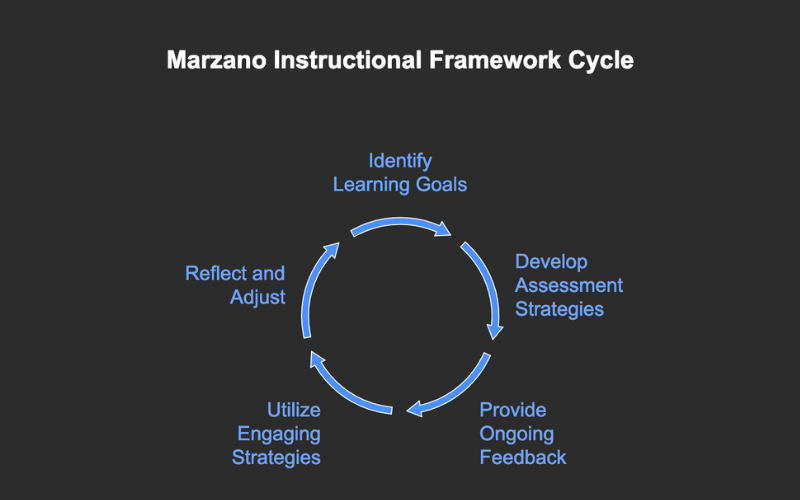The Marzano Framework is a comprehensive instructional framework designed to enhance teaching effectiveness and improve student learning outcomes. Developed by Dr. Robert J. Marzano, this framework offers a structured approach for educators to assess and refine their teaching practices. In this guide, we explore the origins, key components, and practical implementation of the Marzano Framework, as well as its impact on classroom dynamics and student achievement.
Key Features Within The Marzano Framework:
- Based on 40 years of educational research
- Designed to define educational goals and target professional development
- Provides specific criteria for effective teacher evaluation within a structured teacher evaluation model
- Includes tools like checklists, observation sheets, and other helpful documents
The Marzano Framework provides educators with evidence-based strategies that align with current educational research. By embracing this framework and its classroom strategies, educators can create a more effective learning environment tailored to meet the diverse needs of their students. This adaptability is crucial in today’s classrooms, where student demographics and learning styles can vary widely. The framework not only aims to improve academic performance but also fosters a positive classroom culture that encourages collaboration and critical thinking.
The Origins of the Marzano Framework
Dr. Robert J. Marzano, a prominent educational researcher, developed the Marzano Framework based on years of research on effective teaching practices. His work emphasizes a systematic approach to instruction that integrates cognitive science, assessment practices, and instructional strategies. The framework is grounded in the belief that effective teaching leads to improved student outcomes. Dr. Marzano’s insights have been instrumental in reshaping educational paradigms, moving away from traditional rote learning to more dynamic and interactive learning experiences.
Since its inception, the Marzano instructional framework has undergone continual refinement, incorporating ongoing research and feedback from educators implementers. The framework has evolved into a popular model embraced by schools and districts across the globe. Notably, it has been adapted to fit various educational contexts, from urban to rural settings, and has proven effective in diverse classrooms, making it a versatile tool for educators everywhere.
Key Principles of the Marzano Framework

At the core of the Marzano Framework are several key principles that guide educators in their instructional practices to enhance teacher effectiveness:
- Clear Learning Goals: Establishing specific and measurable learning objectives helps students understand what is expected of them. This clarity not only aids in student comprehension but also empowers them to take ownership of their learning journey.
- Feedback: Timely and constructive feedback is vital for helping students track their progress and identify areas for improvement. This principle emphasizes the importance of a growth mindset, encouraging students to view challenges as opportunities for development rather than setbacks.
- Cognitive and Metacognitive Strategies: Encouraging students to think about their own thinking enhances their understanding and learning experience. By fostering metacognitive awareness, students become more adept at self-regulation, allowing them to apply learned strategies across different subjects and contexts.
- Engaging Instruction: Utilizing various instructional strategies to actively involve students in their learning is essential for motivation. Techniques such as cooperative learning, project-based assignments, and technology integration not only make lessons more interactive but also cater to various learning preferences, ensuring that all students remain engaged and invested in their education.
Is the Marzano Framework Effective?
Yeah. Marzano is considered to be a strong, research-based observing system. This framework has been simplified and concentrated to allow the researcher to focus on core instructional practices that directly impact student achievement and learning. By honing in on these essential elements, educators can streamline their efforts to improve teaching effectiveness and student outcomes.
The Marzano Framework’s emphasis on specific criteria for teacher evaluation and professional development offerings ensures that teachers are equipped with the tools they need to succeed. This approach not only enhances instructional strategies but also fosters a culture of continuous professional growth and reflective practice among educators. As a result, schools that implement the Marzano Framework often see measurable growth in student engagement, critical thinking, and overall academic success.
By providing a common language for teacher observation and feedback, the framework supports a collaborative environment where school leaders and teachers work together to achieve high expectations and set objectives that drive student growth and student success.

The Marzano Framework is closely linked to effective teaching practices, offering valuable tools for educators to enhance their instructional techniques through structured classroom observation. By aligning classroom practices with the framework’s principles, teachers can foster a more effective learning environment.
The Role of the Marzano Framework in Classroom Management
Classroom management is crucial for creating a productive learning atmosphere. The Marzano Framework provides strategies that help educators navigate classroom dynamics effectively. These strategies include setting clear expectations, establishing routines, and fostering positive relationships with students.
When educators implement these management strategies, they create an environment where students feel safe, respected, and engaged. This leads to fewer behavioral issues and allows for more time spent on instruction and learning. Additionally, the framework emphasizes the importance of reflective practices, encouraging teachers to assess their management techniques regularly. By reflecting on what works and what doesn’t, educators can adapt their approaches to better meet the needs of their students, ultimately leading to a more harmonious classroom environment. Professional learning communities also play a vital role by providing resources, rubrics, and collaborative learning opportunities that enhance educators’ understanding and application of these strategies.
The Marzano Framework and Student Engagement
One of the critical components of the Marzano Framework is its emphasis on student engagement. Engaged students are more likely to participate actively in their learning and demonstrate improved academic outcomes. The framework encourages teachers to incorporate diverse instructional methods, such as collaborative learning, problem-solving tasks, and interactive technology.
By varying instructional techniques, educators can capture students’ interests and motivate them to connect personally with the material. This engagement, when combined with clear learning goals and feedback, creates a powerful learning experience. Furthermore, the Marzano Framework advocates for the use of formative assessments to gauge student understanding throughout the learning process. By regularly checking for understanding, teachers can adjust their instruction in real-time, ensuring that all students remain engaged and on track to meet their learning objectives. This responsive approach not only enhances student engagement but also fosters a culture of continuous improvement and growth within the classroom.
Components of the Marzano Framework

The Marzano instructional framework is composed of several interrelated components that work together to facilitate effective teaching and learning. Understanding these components is essential for educators who wish to implement the framework successfully.
The Learning Goals Component
The Learning Goals component emphasizes the importance of setting specific objectives that guide instruction. By communicating these goals to students, educators help them understand the purpose of their learning activities and what they are working toward.
Clear learning goals also serve as a roadmap for both teachers and students. They provide a framework for assessing progress and identifying areas where additional support may be needed. Moreover, when students are aware of their learning targets, they are more likely to take ownership of their educational journey, fostering a sense of responsibility and motivation to achieve their goals.
The Feedback Component
Feedback is a crucial aspect of the Marzano Framework. It involves assessing student performance and providing timely, constructive input that helps students improve. Effective feedback not only highlights areas for growth but also reinforces students’ strengths.
Research indicates that timely feedback leads to higher levels of student achievement. Educators are encouraged to use various forms of feedback, such as verbal feedback during lessons, written comments on assignments, and peer assessments to enhance the learning process. Additionally, fostering a culture of feedback within the classroom can encourage students to view criticism as a valuable tool for growth rather than a negative reflection of their abilities, ultimately promoting a growth mindset.
The Knowledge Application Component
This component focuses on helping students apply their knowledge in real-world contexts. It encourages educators to create authentic learning experiences that allow students to transfer their skills and understanding beyond the classroom.
By facilitating opportunities for knowledge application, educators not only deepen students’ understanding but also prepare them for future challenges. This component advocates for project-based learning, simulations, and problem-solving exercises that require students to use their acquired knowledge creatively. Furthermore, integrating community-based projects can enhance the relevance of the learning experience, as students engage with real-world issues and collaborate with local organizations, thereby fostering civic responsibility and critical thinking skills.
What Are the 9 Marzano Instructional Strategies?

Dr. Marzano asserts that effective instruction is crucial for enhancing student learning, leading to the development of nine strategies designed to elevate student achievement.
- Identifying similarities and differences: Students can better grasp complex concepts by distinguishing and comparing characteristics.
- Summarizing and note taking: By articulating ideas in their own words and identifying key points, students enhance their understanding.
- Reinforcing effort and providing recognition: Teachers can assist students in recognizing the connection between effort, achievement, and acknowledgment.
- Homework and practice: Practice is essential for learning, so homework should be purposeful and lead to specific outcomes rather than being mere busywork.
- Nonlinguistic representations: Concepts and vocabulary are reinforced through visuals, images, dramatic enactments, and pictographs.
- Cooperative learning: Collaborative group work can significantly enhance student learning.
- Setting objectives and providing feedback: Guiding students to set learning goals and offering positive feedback helps steer them in the right direction.
- Generating and testing hypotheses: Encouraging students to form predictions, test them, and explain the results fosters deeper understanding.
- Questions, cues, and advance organizers: These tools help students tap into prior knowledge, organize information, and encourage further learning.
Implementing the Marzano Framework
Implementing the Marzano Framework in a classroom setting requires careful planning and consideration. As a teacher evaluation model, educators should approach this process systematically, taking the time to evaluate their current practices and determine areas for improvement.
Steps to Incorporate the Marzano Framework in Your Teaching

To effectively incorporate the Marzano Framework into teaching practices, educators can follow these steps:
- Identify learning goals tailored to your specific subject and grade level.
- Develop assessment strategies that align with these goals.
- Provide ongoing feedback to students throughout the learning process.
- Utilize engaging instructional strategies to enhance student involvement.
- Reflect on instructional practices and student performance to identify necessary adjustments.
Challenges and Solutions in Implementing the Marzano Framework
Like any educational model, implementing the Marzano Framework may present challenges. Educators may encounter resistance from students or find it difficult to integrate all components seamlessly.
To address these challenges, it is essential to foster a culture of collaboration among educators. Sharing best practices, participating in professional development, and seeking feedback from peers can create a supportive environment for implementation.
Moreover, educators should remain flexible and open to adapting their teaching strategies in response to student needs and feedback. This adaptability can greatly enhance the effectiveness of the Marzano Framework in their classrooms.
The Impact of the Marzano Framework on Student Achievement
The ultimate goal of the Marzano Framework is to improve student success and achievement. Numerous studies have shown a positive correlation between the implementation of this framework and enhanced student performance.
The Marzano Framework and Improved Student Outcomes
Research has demonstrated that classrooms employing the Marzano Framework consistently show higher student achievement rates compared to those that do not. Students benefit from the framework’s structured approach, which allows them to develop a deeper understanding of the course material.
Furthermore, the emphasis on feedback and learning goals helps students take ownership of their learning and performance, leading to improved self-efficacy and motivation.
The Marzano Framework and the Achievement Gap
The Marzano Framework also plays a significant role in addressing the achievement gap among various student demographics. By providing a clear structure for instruction, educators can tailor their approaches to meet the needs of diverse learners.
Evidence suggests that when implemented effectively, the Marzano Framework can reduce disparities in academic performance, promoting equity in educational outcomes. Educators who embrace this framework contribute to creating more inclusive learning environments that support all students.
In conclusion, the Marzano Framework is a powerful tool for educators seeking to enhance their teaching practices and improve student achievement. By understanding its origins, components, and practical applications, teachers can create a positive and impactful learning environment that benefits all students.
What is the Marzano Framework?
The Marzano Framework is an instructional framework designed to improve teaching effectiveness and student learning outcomes. Developed by Dr. Robert J. Marzano, it provides educators with evidence-based strategies and tools for classroom observation, teacher evaluation, and professional development. By focusing on effective instructional practices, the framework aims to enhance student engagement, critical thinking, and academic success.
What are the four domains of the Marzano Framework?
The four domains of the Marzano Framework are Classroom Strategies and Behaviors, Planning and Preparing, Reflecting on Teaching, and Collegiality and Professionalism. These domains guide educators in enhancing teaching effectiveness, improving student learning outcomes, and fostering professional growth through structured teacher evaluation and instructional practices.
What are the 5 dimensions of learning Marzano?
The five dimensions of learning in Marzano’s framework include positive attitudes and perceptions about learning, acquiring and integrating knowledge, extending and refining knowledge, using knowledge meaningfully, and developing productive habits of mind. These dimensions guide educators in creating effective instructional strategies to enhance student learning and achievement.
What are the 3 domains of knowledge in Marzano's new taxonomy?
The three domains of knowledge in Marzano’s new taxonomy are information, mental procedures, and psychomotor procedures. These domains categorize the types of knowledge that students need to develop for effective learning and application within various educational contexts.



